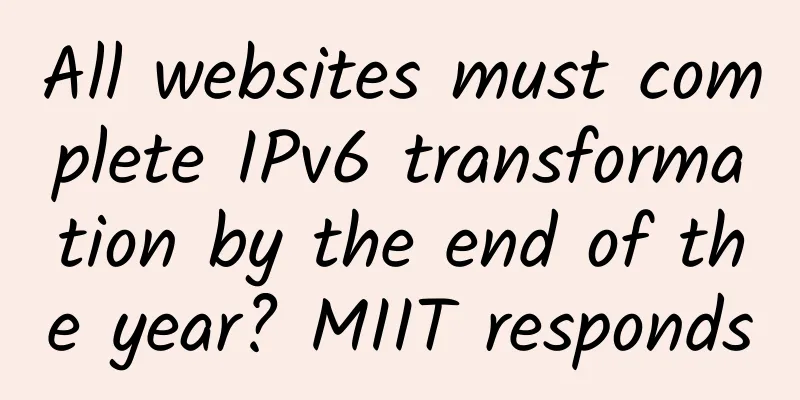Wu Hequan: IPv6+ is an important tool for the third phase of large-scale deployment of IPv6

|
The large-scale deployment of IPv6 in my country has entered the third stage, and IPv6+ is an important tool for the third stage of large-scale deployment of IPv6, Wu Hequan, director of the expert committee for promoting large-scale deployment of IPv6 and academician of the Chinese Academy of Engineering, said at the 2021 "IPv6+" Innovation City Summit Forum. From the "Action Plan for Promoting Large-Scale Deployment of Internet Protocol Version 6 (IPv6)" in November 2017, to the "Three-Year Special Action Plan for Improving IPv6 Traffic (2021-2023)" and the "Notice on Accelerating the Large-Scale Deployment and Application of Internet Protocol Version 6 (IPv6)" in July this year, the issuance of a series of policies has clarified the direction and roadmap for the development of IPv6 in my country. Wu Hequan introduced that as of June this year, my country's IPv6 address resource reserves ranked first in the world; the number of users of IPv6 allocated addresses reached 1.61 billion, ranking second in the world; the number of active IPv6 users reached 535 million, accounting for more than 50% of the total number of Internet users. In terms of infrastructure transformation, LTE networks, metropolitan area networks, Internet backbone networks, and bearer networks all support IPv6. The total IPv6 traffic of metropolitan area networks reaches 15.2T, and the total IPv6 traffic of LTE core networks exceeds 8.9T. The IDCs of the three major basic telecommunications companies have completed IPv6 transformation, and 11 top CDN companies support IPv6 capability coverage nationwide. The TOP 100 commercial websites and applications fully support IPv6 access. The goal of the third phase of large-scale deployment is to make my country the world's No. 1 in terms of IPv6 network scale, IPv6 user scale and IPv6 traffic scale by 2025. Wu Hequan said that the first two have great potential, but there is a big gap in traffic scale, and IPv6+ is needed to enrich the application value of IPv6 and promote the increase of IPv6 traffic. He said that IPv6 is the starting point for the upgrade of the next generation Internet, and the IPv6+ system is a comprehensive capacity upgrade based on the IPv6 network technology system. Its connotation is an intelligent IP network for the 5G and cloud era. IPv6+ can meet the flexible networking of 5G bearer and cloud network integration, rapid service provisioning, simplified network operation and maintenance, optimized user experience on-demand services, differentiated guarantees and other bearer requirements. IPv6+ includes protocol innovations represented by IPv6 segment routing, network slicing, flow detection, new multicast and application-aware networks, and technical innovations represented by network intelligence such as network analysis, automatic tuning, and network self-healing. "We need to make IPv6 networks not only accessible through innovation, but also able to achieve intelligent connection, network variability, and service quality assurance in accordance with users' service requirements." He said that the expert committee has set up a special IPv6+ technology innovation working group for this purpose, integrating "production, education, research and application" in multiple dimensions, and engaging in research on IPv6+ network architecture technology, IPv6+ industry application solutions, and conducting IPv6+ verification pilot projects. According to the plan, the development of the IPv6+ technology innovation system is divided into three stages. The first stage is network programming capabilities (2020-2021), network simplification, partially autonomous networks, rapid issuance of SRv6-BE/TE/Policy services, flexible path control, and automatic configuration. The second stage is user experience assurance (2021-2023), experience assurance, conditional autonomous networks, network slicing, flow detection, new multicast and other large-scale network segmentation, visible experience, and optimal experience. The third stage is application-driven networks (2023-2025), application awareness, and the realization of highly autonomous networks, application-aware networks, application-driven network programming, and network flow-by-flow SLA guarantees. |
>>: Number One "Thousand Faces" - What you see may not be me
Recommend
Practical Tips for HTTPS Deployment on Large Websites
1. Introduction to HTTPS HTTPS (full name: Hyper ...
Let’s talk about the privacy and security of 5G technology
On March 17, 2022, the European Parliament's ...
DediPath New Year Promotion: $15/year KVM-1GB/10GB/1Gbps unlimited traffic/Los Angeles data center
As the Chinese New Year is approaching, DediPath ...
Where is the future of 5G terminals?
[[400174]] In the 5G era, in order to rapidly adv...
4 Steps to Prepare Before Deploying SD-WAN
Software Defined Wide Area Networks (SD-WAN) are ...
There are so many network structures, this one is probably the most controversial one
Since its birth in the 1960s, network technology ...
Reject poor digital experience! Riverbed creates agile and visual management solutions
According to an IDC report, by 2018, 67% of the w...
HostYun: Los Angeles/Japan/Korea/Hong Kong VPS monthly payment starts from 15 yuan, KVM architecture, CN2 GIA and other lines
HostYun is a Chinese VPS hosting company founded ...
CMIVPS: Hong Kong high-bandwidth VPS hosting, 20% off for monthly payment, 30% off for half-year payment, direct line 5-100Mbps bandwidth
CMIVPS is a foreign hosting service provider esta...
20,000 words of detailed explanation! 32 classic questions about Netty!
Introduction Hello everyone, I am Tianluo. When w...
Talk about TCP's three-way handshake and four-way wave
[[379162]] 1. Introduction to Transmission Contro...
Risks and opportunities in the 5G era
At the end of 2018, the 5G frequency allocation o...
CUBECLOUD: Los Angeles/Hong Kong Lite series 30% off from 27 yuan/month, Pro series 15% off from 58 yuan/month
CUBECLOUD is a Chinese hosting company establishe...
5G unlocks new solutions for the medical industry
5G unlocks new solutions for the medical industry...
In the face of the epidemic, 5G helps: the four major operators collectively press the "fast forward button"
Recently, the top leadership held a meeting to sp...









![[11.11] Tencent Cloud 2C2G4M cloud server starts at only 50 yuan/year, 2C4G6M cloud server only 100 yuan/year](/upload/images/67cac04ca9a14.webp)